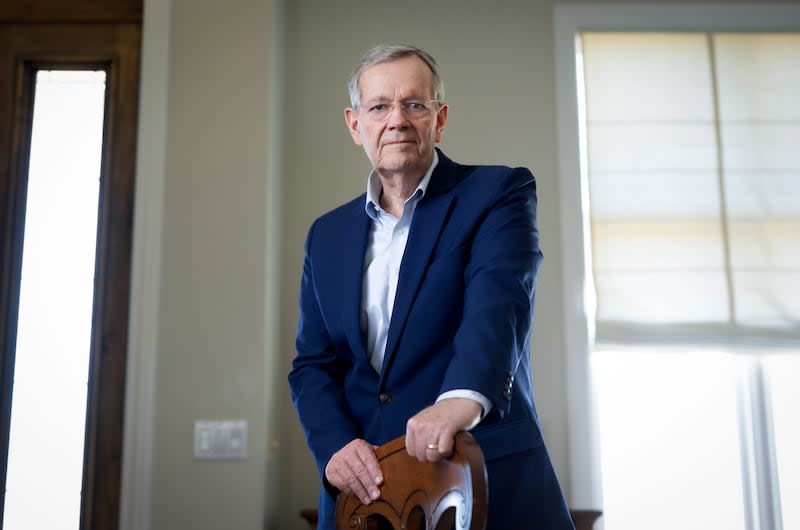Former Gov. Leavitt has a gift for you, and it might just reveal the future

- Oops!Something went wrong.Please try again later.
Mike Leavitt remembers the moment when clarity hit him.
He was driving between the White House and his office at the Department of Health and Human Services, where he served as a Cabinet secretary in the administration of George W. Bush. Politics and policy are a big part of Leavitt’s professional life and he was pondering his 10 years of work as Utah’s 14th governor, and his decision to leave that behind to work as administrator of the Environmental Protection Agency before moving to his role at HHS.
“Headed down Pennsylvania Avenue you stop at the light at the National Archives and there are two statues,” he recalled, thinking of that day more than a decade ago. There are four statues on this noteworthy block; the two along Constitution Avenue represent “Heritage” and “Guardianship.” But here, at a stop light on Pennsylvania Avenue, his attention turned to the two known as “Past” and “Future.”
“On that statue is this inscription: ‘What is past is prologue.’ Now, I had heard the phrase before,” he said, noting its origin in Shakespeare’s “The Tempest,” “but it struck me as I read it then that it is true. And I’ve experienced that. And I was in the process of doing some of this writing at that time and that’s when I became focused.”
Leavitt releasing his memoir
The result is a remarkable four (soon-to-be five) volume electronic memoir, years in the making, available today at www.leavitthistory.com, that could help shape the future of Utah. It’s a memoir, given to the public for free, that can also serve as a guide for policymakers to show how government can overcome obstacles to move things forward. The stories are fascinating, as Leavitt’s experience with problem-solving reveals things even policy wonks will find surprising.
What Bill Walsh was to football coaches in “Finding the Winning Edge,” Michael O. Leavitt is to leadership and public policy with “A personal history and public service memoir.” It reveals that everything he and his team worked on back in the ’90s when he was governor are present again and will require equal amounts of attention, innovation and collaboration to address.

“In my time working closely with Mike Leavitt, I often reflected on what distinguished his service. What made him different? I think the answer to this question is twofold,” said Natalie Gochnour, associate dean in the David Eccles School of Business and director of the Kem C. Gardner Policy Institute at the University of Utah.
“First, he possesses an uncanny ability to see the future and lead change. He did this as he led Utah’s transformation to the Information Age, helped build our modern transportation system, and changed the philosophy of our welfare system, just to name a few. Second, he combines his leadership acumen with inherent goodness in his words and his actions. He understood and emulated the sacred trust of public service.”
Leavitt’s inspiration
Leavitt had another inspiration for his memoir, and it came from his great-great-great-grandmother, Sarah Sturtevant, in the form of a six-page personal history.
“She was not well educated. I could hardly read her handwriting. Her spelling had to be phonetically worked out. There was no punctuation in it. Yet I found it fascinating,” Leavitt said. “It was about her life and what she had experienced, and they weren’t profound things. They were ordinary things, but I was interested in it. And it dawned on me in the course of that reading that this is a century-and-a-half later. ... It didn’t matter how sloppy it was, or how halting the written style was, I really valued it.”
That jump-started the process of putting word to paper.
“I like to tell stories,” Leavitt told me, as we sat at his dining room table in his Salt Lake City home. “But I felt like my stories were getting stale. I was reusing them. And I needed to harvest some of my own experiences. So on a Sunday afternoon, I sat down with a yellow pad and started to think of incidents in my life that might have some value,” he said.
The page on that yellow pad filled within an hour. Then it became 100 ideas and stories. And then 1,000. Themes formed as possible buckets of information, if not chapters. He then worried about losing the yellow pads, so he began writing digitally. Such was the pattern — write on a Sunday afternoon, let it sit a while, and then see in which bucket it would land. It was a process that began in earnest in Washington, D.C., and continued when he returned to Utah, where he founded Leavitt Partners and most recently became president of the Tabernacle Choir at Temple Square.
‘What is past is prologue’
What has emerged in the memoir are rich stories and a very clear message: Everything of significance that needed attention during Leavitt’s three terms as governor from 1993 to 2003 has arisen again as a current need.
The internet was threatening to change everything back then. Today it’s artificial intelligence.
The state’s rapid growth brought a need to update I-15 and bring in rail. That infrastructure now needs expanding as growth continues, straining transportation, as well as housing and water.
And what about that lead-up to the 2002 Olympics? We’re back at it again, with a formal announcement expected this summer that the Games will return to Utah in 2034. This gives the state and Salt Lake City a chance to come together to maintain Utah’s nationally recognized economy and quality of life.
The past can inform the future. “What is past is prologue.”
On Monday, the Deseret News and the Kem C. Gardner Policy Center are hosting three roundtable discussions with panels on population growth and infrastructure, technology and public education. It focuses on the “Big Gears” that drive success, with a clock as an apt metaphor. Turn the large gear of a clock and the other smaller gears turn with it. The invitation-only event features experts in each field learning from Utah’s past experiences to inform the present and the future. Additional sessions will be held April 5 at the Gardner Center and in two weeks in Southern Utah.
The Deseret News will cover this event and continue to highlight lessons from Leavitt’s memoir.
“A leader like Mike Leavitt comes along maybe once every hundred years. We are fortunate to be beneficiaries of his service,” said Gochnour.
The memoir includes:
Volume 1: “My life. Childhood, young adulthood, marriage and children, professional life, and a detailed account of my entry into politics and public service.”
Volume 2: “Staffing decisions, the media, Legislature, politics, relationships with important constituencies and the struggle to maintain personal balance amid intensity.”
Volume 3: “Eight enduring legacy accomplishments and the controversies surrounding them. Also, my transition to national government service.”
Volume 4: “How my service as governor affected my family.”
Expected next year is a final volume of Leavitt’s experience working in the Cabinet of George W. Bush.
Note: Doug Wilks is executive editor of the Deseret News.

